
The Silurians are a race of reptilian humanoids in the long-running British science fiction television series Doctor Who, who first appeared in Doctor Who in the 1970 serial Doctor Who and the Silurians, and were created by Malcolm Hulke. The first Silurians introduced are depicted as prehistoric and scientifically advanced sentient humanoids who predate the dawn of man; in their backstory, the Silurians went into self-induced hibernation to survive what they predicted to be a large atmospheric upheaval caused by the Earth capturing the Moon.

Invasion of the Dinosaurs, simply titled Invasion in Part One, is the second serial of the 11th season of the British science fiction television series Doctor Who, which was first broadcast in six weekly parts on BBC1 from 12 January to 16 February 1974.
Mindwarp is the second serial of the larger narrative known as The Trial of a Time Lord which encompasses the whole of the 23rd season of the British science fiction television series Doctor Who. It was first broadcast in four weekly parts on BBC1 from 4 to 25 October 1986. The title Mindwarp is not used on screen and appears only on the serial's scripts with the four episodes that comprise the story being transmitted as The Trial of a Time Lord Parts Five to Eight. This story marks the final appearance of Nicola Bryant as Peri Brown.
Terror of the Autons is the first serial of the eighth season of the British science fiction television series Doctor Who. It was broadcast in four weekly parts on BBC1 from 2 to 23 January 1971.
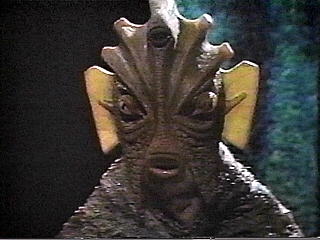
Doctor Who and the Silurians is the second serial of the seventh season in the British science fiction television series Doctor Who. It was first broadcast in seven weekly parts on BBC1 from 31 January to 14 March 1970.
The Dæmons is the fifth and final serial of the eighth season of the British science fiction television series Doctor Who, which was first broadcast in five weekly parts on BBC1 from 22 May to 19 June 1971.

Malcolm Ainsworth Hulke was a British television writer and author of the industry "bible" Writing for Television in the 70s. He is remembered chiefly for his work on the science fiction series Doctor Who although he contributed to many popular television series of the era.
The Green Death is the fifth and final serial of the tenth season of the British science fiction television series Doctor Who, which was first broadcast in six weekly parts on BBC1 from 19 May to 23 June 1973. It was the last regular appearance of Katy Manning as companion Jo Grant.
Frontier in Space is the third serial of the tenth season of the British science fiction television series Doctor Who. The serial was first broadcast in six weekly parts on BBC1 from 24 February to 31 March 1973. It was the last serial to feature Roger Delgado in the role of the Master.
Revenge of the Cybermen is the fifth and final serial of the 12th season of the British science fiction television series Doctor Who, which was first broadcast in four weekly parts on BBC1 from 19 April to 10 May 1975. It was the first to feature the Cybermen since The Invasion (1968) and the last until Earthshock (1982).
Colony in Space is the fourth serial of the eighth season of the British science fiction television series Doctor Who, which was first broadcast in six weekly parts on BBC1 from 10 April to 15 May 1971.
Warriors of the Deep is the first serial of the 21st season of the British science fiction television series Doctor Who, which was broadcast in four twice-weekly parts on BBC1 from 5 to 13 January 1984.
The Ambassadors of Death is the third serial of the seventh season of the British science fiction television series Doctor Who, which was first broadcast in seven weekly parts on BBC1 from 21 March to 2 May 1970. The serial's script was credited to David Whitaker but completed primarily by Malcolm Hulke and Trevor Ray. It was directed by Michael Ferguson.
Malcolm Clarke was a British composer and experimental electronic musician. He was a member of the BBC Radiophonic Workshop, which was based in Maida Vale, London, for 25 years from 1969 to 1994.
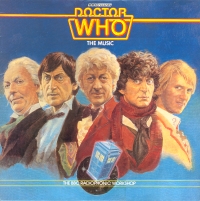
Doctor Who: The Music is a 1983 compilation of music from the BBC Radiophonic Workshop featuring incidental music from the popular science-fiction television series Doctor Who. The album was the first full-length to feature solely music from the programme. The collection was produced by Workshop member and long-time Doctor Who sound-effects creator Dick Mills. It featured the original Delia Derbyshire arrangement of Ron Grainer's theme tune and music by Malcolm Clarke from the 1972 serial "The Sea Devils", which was only the second to have an incidental score provided completely by the Radiophonic Workshop. Most of the music included came from serials from the previous three years to demonstrate the recent composers' works. For the album, each serial's incidental music was reassembled into short "suites" and although most of the music had been recorded in mono it was, for this compilation, remixed into stereo with sound effects added on to some tracks. The album was re-released in 1992 by Silva Screen records as Earthshock - Classic Music From The BBC Radiophonic Workshop Volume 1, with bonus tracks including "The Worlds of Doctor Who", a track recorded by Mills as a B-side to Dudley Simpson's 1973 "Moonbase 3" single, which featured a mix of music with sound effects from Planet of the Daleks before following with Simpson's "Master's Theme" and finishing with music from the serial The Mind of Evil. Selections from both this compilation and its follow-up, Doctor Who: The Music II, were also re-used on the 1994 Silva Screen compilation The Best of Doctor Who Volume 1: The Five Doctors.

Doctor Who at the BBC Radiophonic Workshop Volume 2: New Beginnings 1970–1980 is the second in a series of compilations of BBC Radiophonic Workshop music from Doctor Who. The album collected various incidental music from the 1970s including, for the first time, the complete Malcolm Clarke score for the 1972 serial The Sea Devils, only the second scored completely by the Radiophonic Workshop. The compilation also featured a few of Dudley Simpson's compositions as realised by Brian Hodgson, some Delia Derbyshire music as featured in Inferno, two Peter Howell demos from 1979 and a selection of Dick Mills' sound effects from the era.
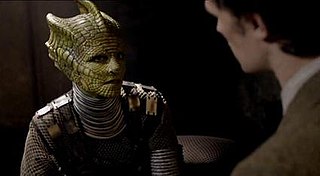
"The Hungry Earth" is the eighth episode of the fifth series of the British science fiction television series Doctor Who, which was first broadcast on 22 May 2010 on BBC One. It was written by Chris Chibnall, who had previously written for Doctor Who and its spin-off series, Torchwood. It is the first episode of a two-part story, the second episode being "Cold Blood", and features the return of the Silurians, a reptile-like humanoid race last seen in 1984's Warriors of the Deep.
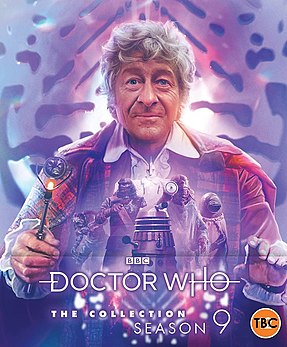
The ninth season of British science fiction television series Doctor Who began on 1 January 1972 with Day of the Daleks, and ended with The Time Monster. This is the third series of the Third Doctor, played by Jon Pertwee, as well as the third to be produced by Barry Letts and script edited by Terrance Dicks.
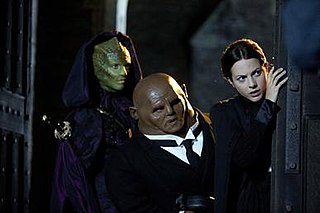
Madame Vastra, Jenny Flint, and Strax, are a trio of recurring fictional characters in the British science fiction television series Doctor Who, created by Steven Moffat and portrayed, respectively, by Neve McIntosh, Catrin Stewart, and Dan Starkey.









